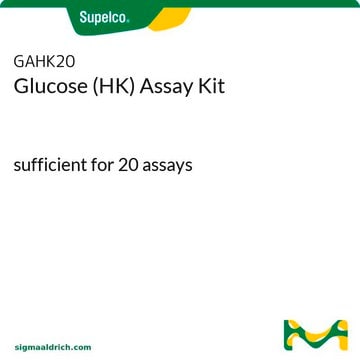MAK465
Glycogen Assay Kit
sufficient for 100 colorimetric or fluorometric tests
Sinónimos:
Glycogen Quantification Kit
Iniciar sesiónpara Ver la Fijación de precios por contrato y de la organización
About This Item
UNSPSC Code:
12161503
NACRES:
NA.84
Productos recomendados
Quality Level
application(s)
pharmaceutical
detection method
colorimetric
fluorometric
relevant disease(s)
diabetes; endocrinological disorders
shipped in
wet ice
storage temp.
−20°C
Categorías relacionadas
General description
Glycogen is a branched polysaccharide of glucose units linked by α-1,4 glycosidic bonds and α-1,6 glycosidic bonds. It is stored primarily in the liver and muscle and forms an energy reserve that can be quickly mobilized to meet a sudden need for glucose. The most common glycogen metabolism disorder is found in diabetes, in which liver glycogen can be abnormally accumulated or depleted due to abnormal amounts of insulin. Genetic glycogen storage diseases have been associated with various inborn errors of metabolism caused by deficiencies of enzymes necessary for glycogen synthesis or breakdown.
Features and Benefits
- Linear detection range: 2 to 200 µg/mL glycogen for colorimetric assays and 0.2 to 20 µg/mL for fluorometric assays.
- Convenient room temperature assay. The procedure involves adding a single working reagent, and and takes only 30 minutes
Suitability
The kit is suitable for the quantitative determination of glycogen in biological samples such as tissue and cells, as well as the evaluation of drug effects on glycogen metabolism.
Principle
The Glycogen Assay Kit uses a single working reagent that combines the enzymatic break down of glycogen and the detection of glucose in one step. The color intensity of the reaction product at 570 nm or fluorescence intensity at λEx = 530 nm/λEm = 585 nm is directly proportional to the glycogen concentration in the sample.
signalword
Danger
hcodes
pcodes
Hazard Classifications
Resp. Sens. 1
Storage Class
10 - Combustible liquids
wgk_germany
WGK 3
Certificados de análisis (COA)
Busque Certificados de análisis (COA) introduciendo el número de lote del producto. Los números de lote se encuentran en la etiqueta del producto después de las palabras «Lot» o «Batch»
¿Ya tiene este producto?
Encuentre la documentación para los productos que ha comprado recientemente en la Biblioteca de documentos.
Nuestro equipo de científicos tiene experiencia en todas las áreas de investigación: Ciencias de la vida, Ciencia de los materiales, Síntesis química, Cromatografía, Analítica y muchas otras.
Póngase en contacto con el Servicio técnico


